Woodwork: Tomoshi Nagano
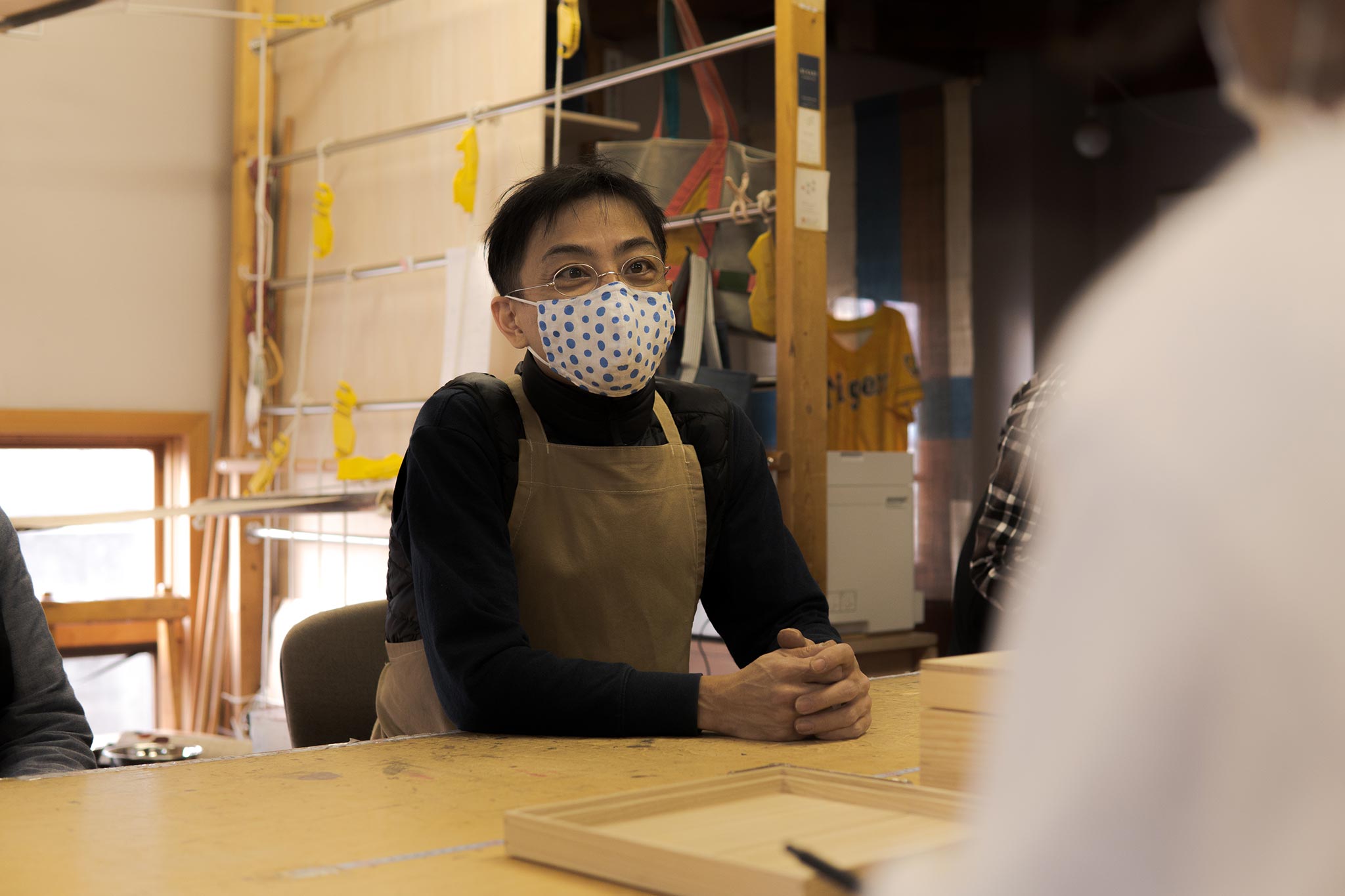
The first words I heard from woodworker Tomoshi Nagano about his current career in woodworking came from an unexpected source: "I had no interest in making things.” Tomoshi loves music and wanted to be a sound effects or recording engineer. After graduating from a music college, he was unexpectedly introduced by an acquaintance to help building a log cabin. It was there that he met a log builder who became his starting point and led him into a career in woodworking, which makes his life interesting.
“He's a designer, but he's always on site, working on his own. He was a carpenter and a builder at heart. His influence made me want to be involved in all aspects of building”, Tomoshi said.
“It was a log cabin, and there are a lot of holiday villas, I could not get to stay for a few months or stay in the certain place to create things at a time, this was the most difficult situation. I thought it would be better for me to stay in one place to make things, so I felt that I could make furniture by myself to a certain level. This is what I thought at that time.”
After a switch from music, Tomoshi got a job at a woodworking company in Nara. There he learned the basic techniques and know-how of furniture making, from making the company brand products to producing works for designers. On his days off, he would take advantage of the free use of the machines in the woodshop after hours to explore his own furniture making. From design to production, he literally did everything by himself and continued trial and error on the days.
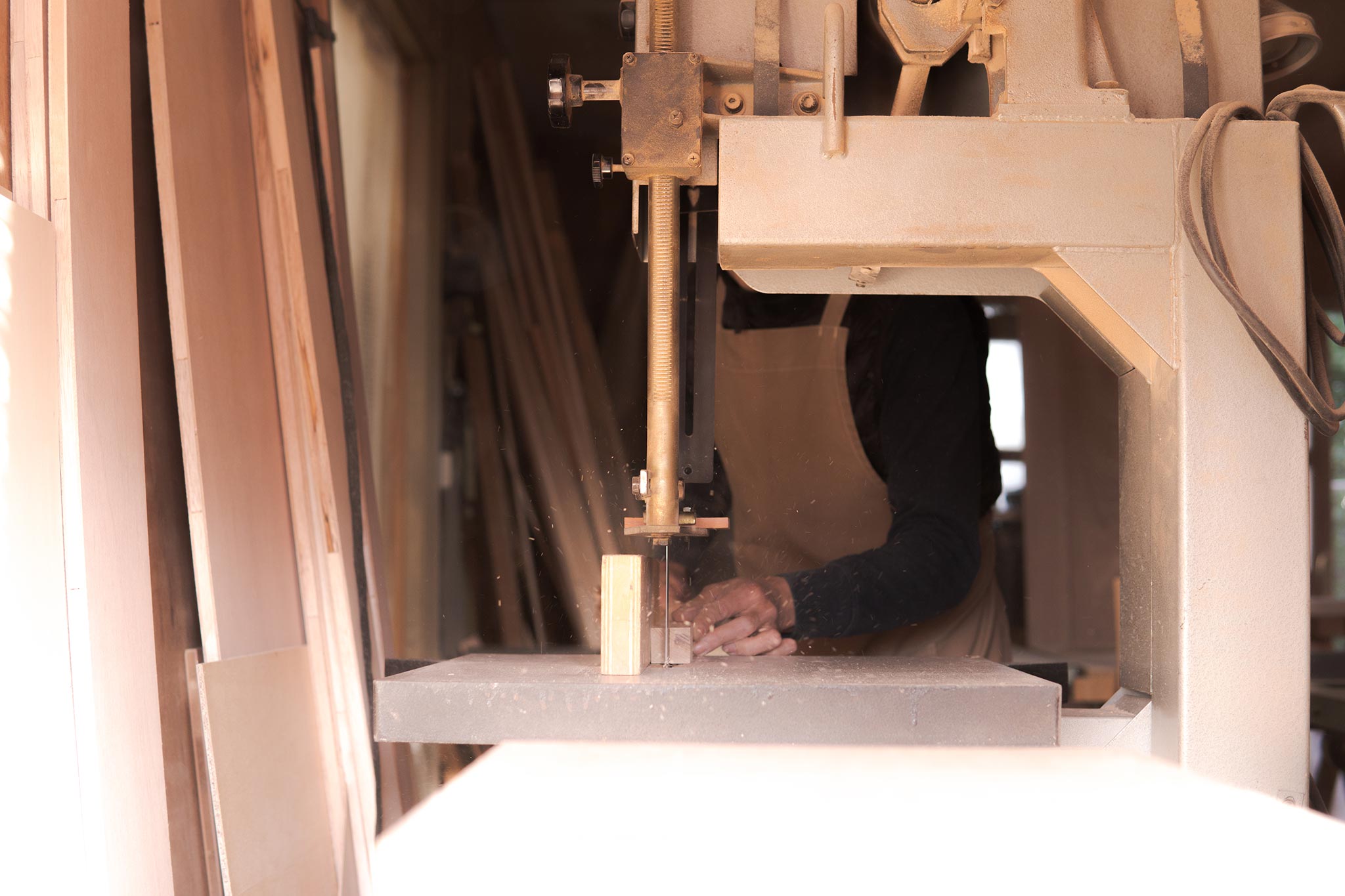

Tomoshi's daily immersion in furniture design gradually led him to become fascinated by the traditional architecture and woodwork of authentic Europe.
“At that time, Kari Virtanen* from Finland's “NIKARI” came to Japan. Kari Virtanen's partner was a Japanese felt artist called Sakata Rutsuko, who was an old friend of my mother. So I asked Kari if I could meet him.”
Tomoshi says that when Kali came to Japan, asked him to take a look what he had made. At that time, he pointed out to me in detail: “You should do more better”, which made me realize how uneducated I was. Then came the events that would define his life as a woodworker.
After Kari returned to Finland, his partner Ruzko called me and said, “The man who I met in Japan, do you think he will come to Finland?” He asked me if I would like to work at his company “NIKARI”. I immediately replied, “I'll go!”
For the next five years, Tomoji worked as a furniture maker in Finland with NIKARI. He really wanted to work at NIKARI to make Kari Virtanen's product. But after five years, he decided to return to Japan, and set up his own furniture making business. At the same time, he wanted to introduce the quality of “NIKARI” products in Japan and concluded a license agreement to produce “NIKARI”. Thus, in 2010, he established Nagano Seisakusho in Uji, Kyoto, where he was born and grown up. He has started to produce two lines of wood furniture under his own original brand “imous-design” and “NIKARI”.
※NIKARI: Furniture manufacturer founded in 1967 by furniture maker Kari Virtanen. Based in the Finnish village of Fiskars, the company has played a pioneering role in the modern Finnish culture of woodworking and furniture making for more than 50 years.
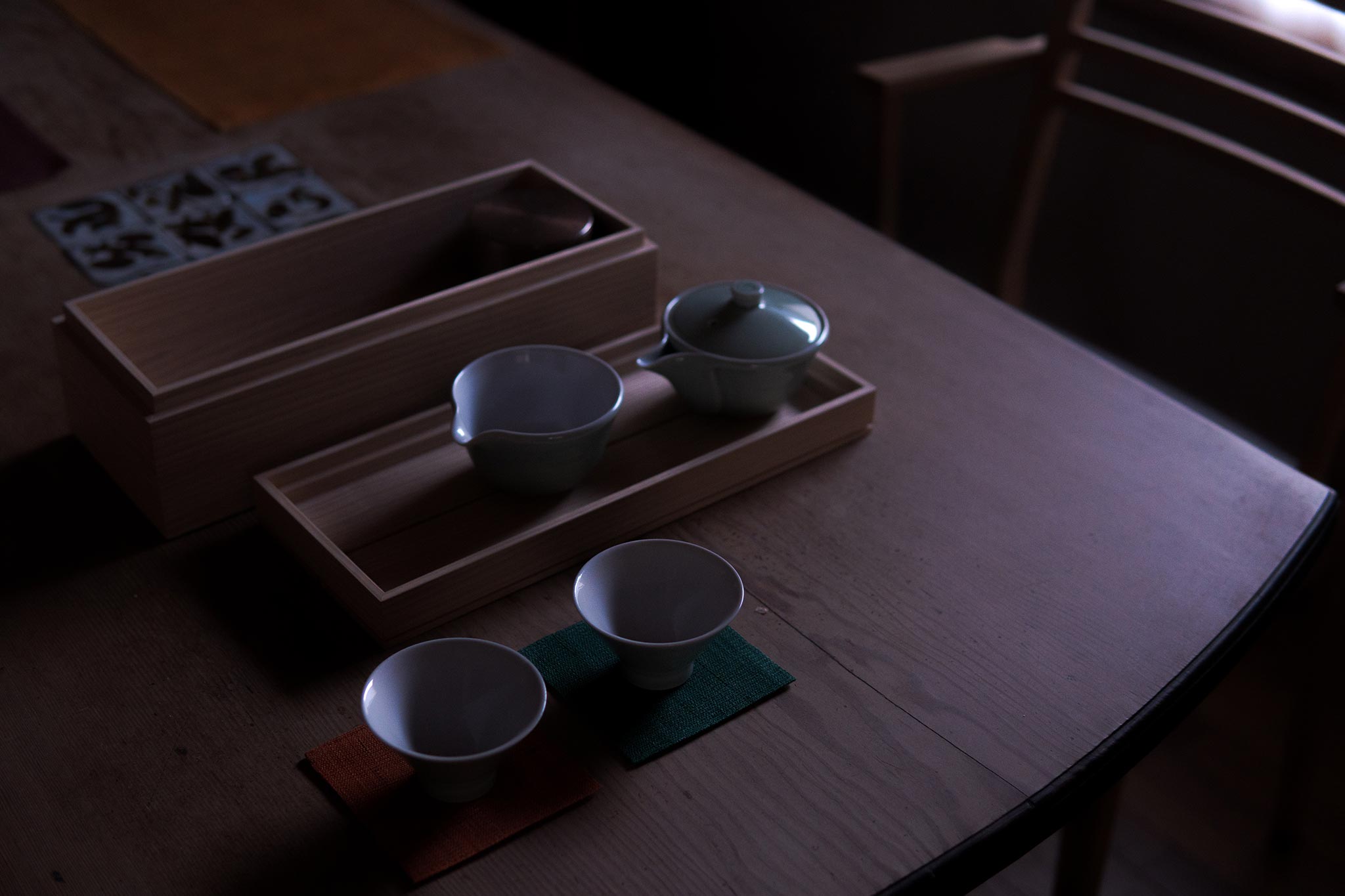
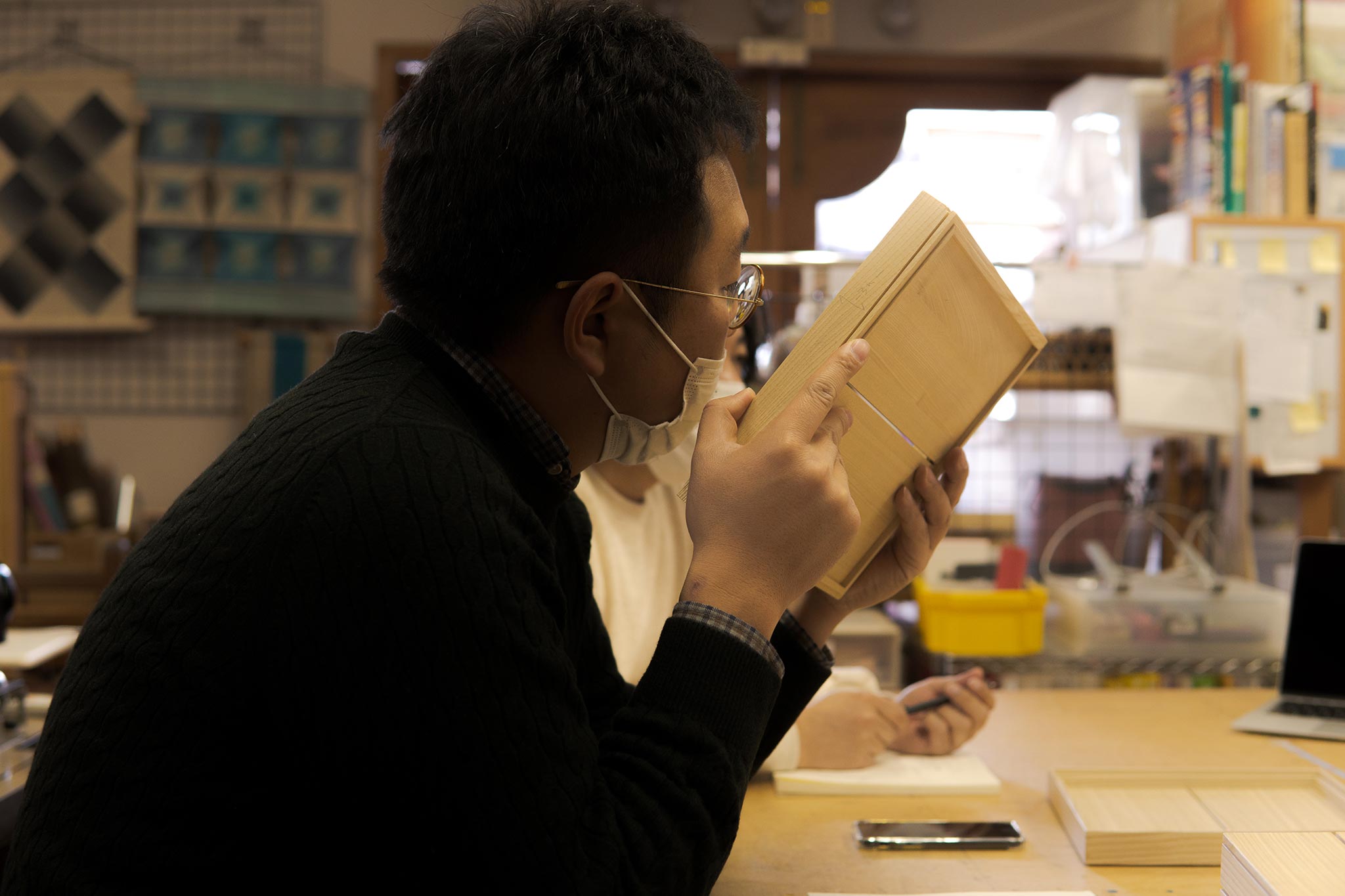
In 2012, Asahiyaki Hosai Matsubayashi asked Tomoshi to create a modern, furniture-like, non-decorative image of the chabitsu (a tray with a lid) found in ryokan (Japanese inns) as a “tea box” that could be used on a table as well as in a Japanese room.
This “tea box” is made of wood called “sen” ,Kalopanax, from Hokkaido. This wood may not be familiar to everyone. How did Tomoshi come up with his unique “tea box”, which looks like a piece of Scandinavian NIKARI furniture, but with the linear beauty of Japanese style?
“Kalopanax varies a lot. To be honest, it's not the easiest wood to work with. In this tea box, we have been very particular about the choice of wood grain and the stripping of grains. There is not large wood, so we have to use thinner pieces of wood, but it doesn't look so obvious, does it? We paid a lot of attention to the details, such as the natural appearance of the peeling, the orientation of the wood and the adjustment of the colour. If I don't get it right, these simple design don't come together.”
We had to stop production for a while because Kalopanax were getting hard to find, but now we have found a wood shop that carries them again and we have just restarted production. This is the difficult thing about domestic wood. In Japan, there are very few plantations of broadleaf trees, and most of them are native trees, so they are marketed according to what has come out of land development or what has grown together with cypress and cedar forests. It is an unstable availability of materials. Once a tree is cut down, it takes at least 50 or 100 years, so it's hard to get the next one.
The design with the gap in the center is also intended. Wood has a directional fiber structure which expand and contract with moisture. This is called a “shiguchi”, or trench, digging a ditch. So it is made to move in this groove here, for about 1% expansion and contraction here. This is an inevitable function, but by incorporating it as a design element, we created a design in which the same slit is inserted. Everything in design has a meaning and a function. This is also what I learned from “NIKARI”.
This tea tray was produced a couple of years after we made the tea box. It was designed to be used for placing summer dishes, the width of the grooves on the handle was initially evenly spaced, but we decided that it would be easier to hold if the bottom of the grooves were wider, so we settled on this ratio. Looking at it from a design point of view, equal spacing might be more aesthetically pleasing, but my approach is that design should follow usability and functionality.
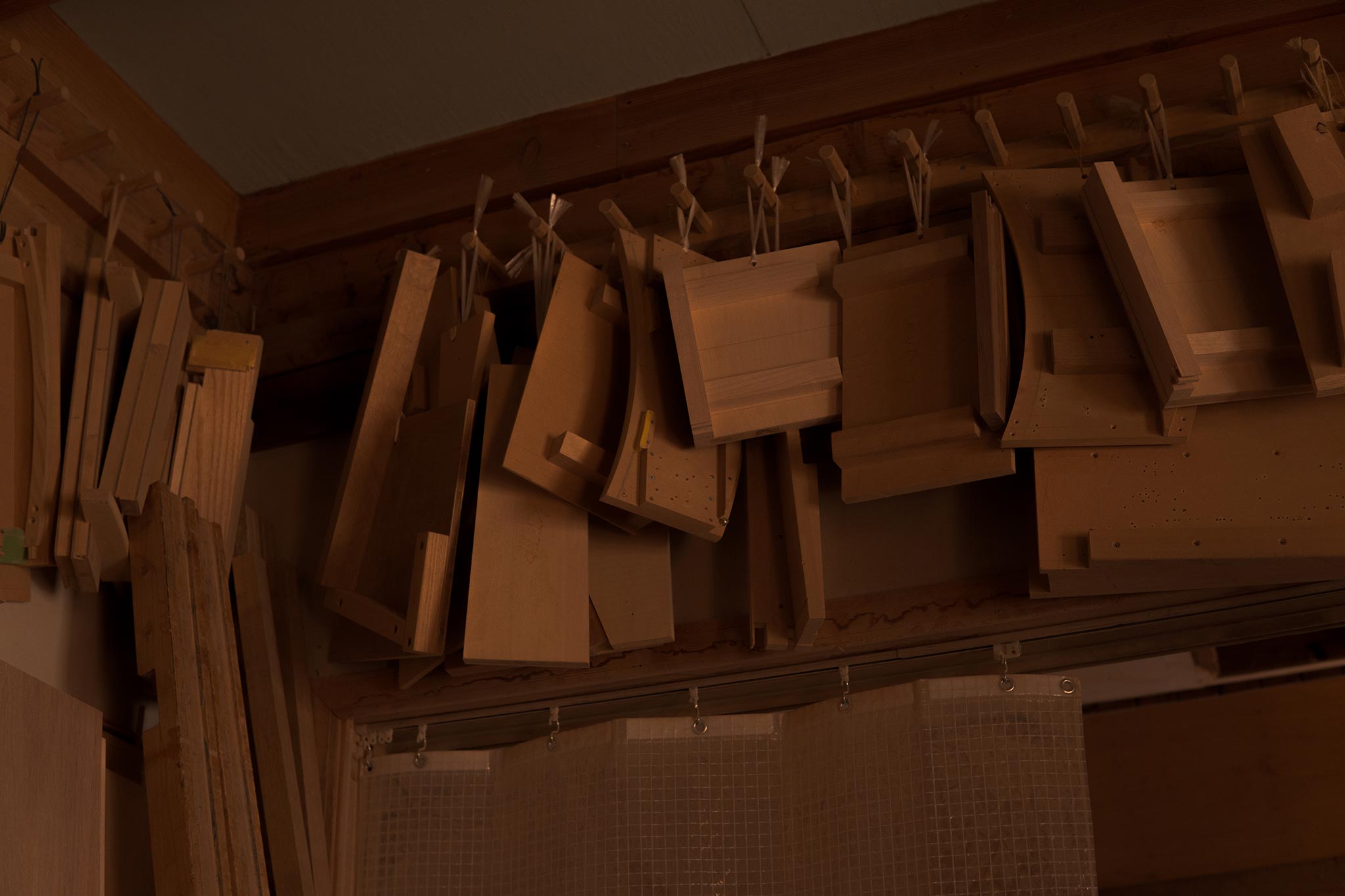
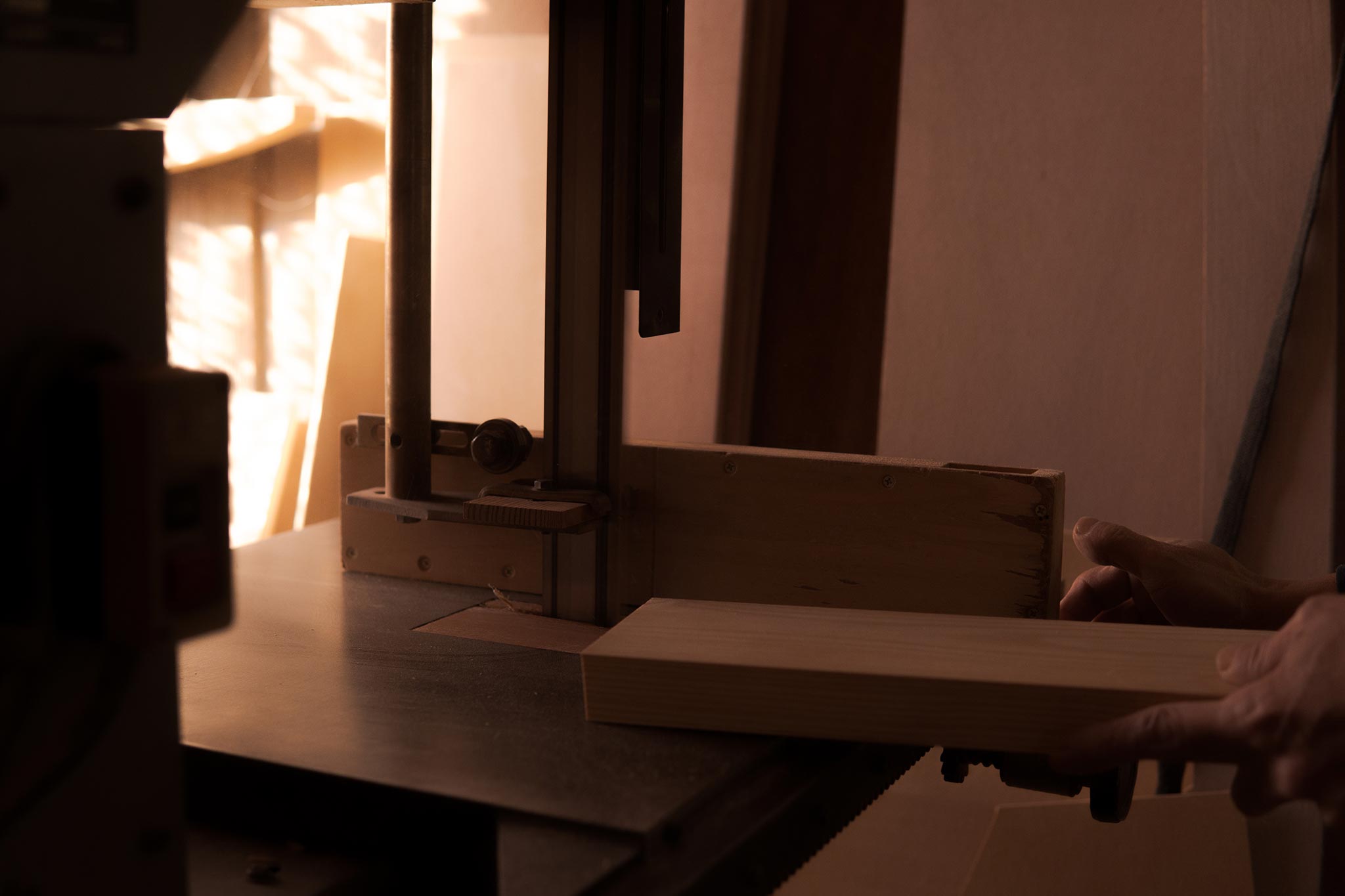
Tomoshi has brought the woodworking know-how he learned at NIKARI in Finland back to Japan, but he sometimes feels that Japanese manufacturing is in danger.
“In simple technical terms, Japan is more technologically advanced than other countries, but we are not making the best use of our technology. The use of plywood has become the dominant material in woodworking. But if you look back at traditional Japanese techniques, originally they would have only been solid. But the emphasis on productivity and distribution has meant that solid woodworking has been reduced.”
“Solid wood has a direction along its fibres, and if the direction is wrong, it will be broken. Understanding the nature of wood and making furniture without overworking it. What I have learnt at NIKARI is to use solid materials correctly and to build the furniture in the right way.”
Highly influenced by Kari Virtanen, Tomoshi's furniture looks very Scandinavian to Japanese. However, from a Finnish point of view, his design is sometimes considered to be “Japanese”.
“I am very much influenced by Kari Virtanen and I think my designs are very NIKARI-like, but from their point of view, they probably associate elements of my designs with Japanese images such as narrow lattices, shoji screens and crafted fittings. They have the image of “carving”, while Japan has the image of “assembling”. The year before last, when we held an exhibition of chairs at Ryosokuin temple, put this chair on the floor and even though the chair itself is Scandinavian in design, it naturally fits in with the Japanese architecture. This is interesting because it shows that design is not a universal language, but is rooted in local and ethnic cultures.

Looking at Tomoshi's work, it seems as if he “enjoys the trial and error itself”. Rationality alone may sound a little tasteless, but the problem-solving process itself is undoubtedly a source of creativity for Tomoshi. He was like an innocent little boy, explaining to us all the secret ideas he had that we couldn't share with you.
“I still want to be involved from the beginning to the end, because I don't think I have a complete grasp of woodworking yet. I'm still learning, the trial and error, which is the interesting point of this job. When I am asked to make something like this, think about it and try to solve the problem. This is another reason why I want to keep making “NIKARI” products. That's why I don't think of myself as an artist, I think of myself as a woodworker.”
“To be a craftsman, not an artist”. This is exactly the same thing that can be said about Asahiyaki craftsmanship. In my conversation with Tomoshi, I realized that the beginning and the mastery are never far apart, but always inextricably linked.
Dyeing: Miwako Nagano
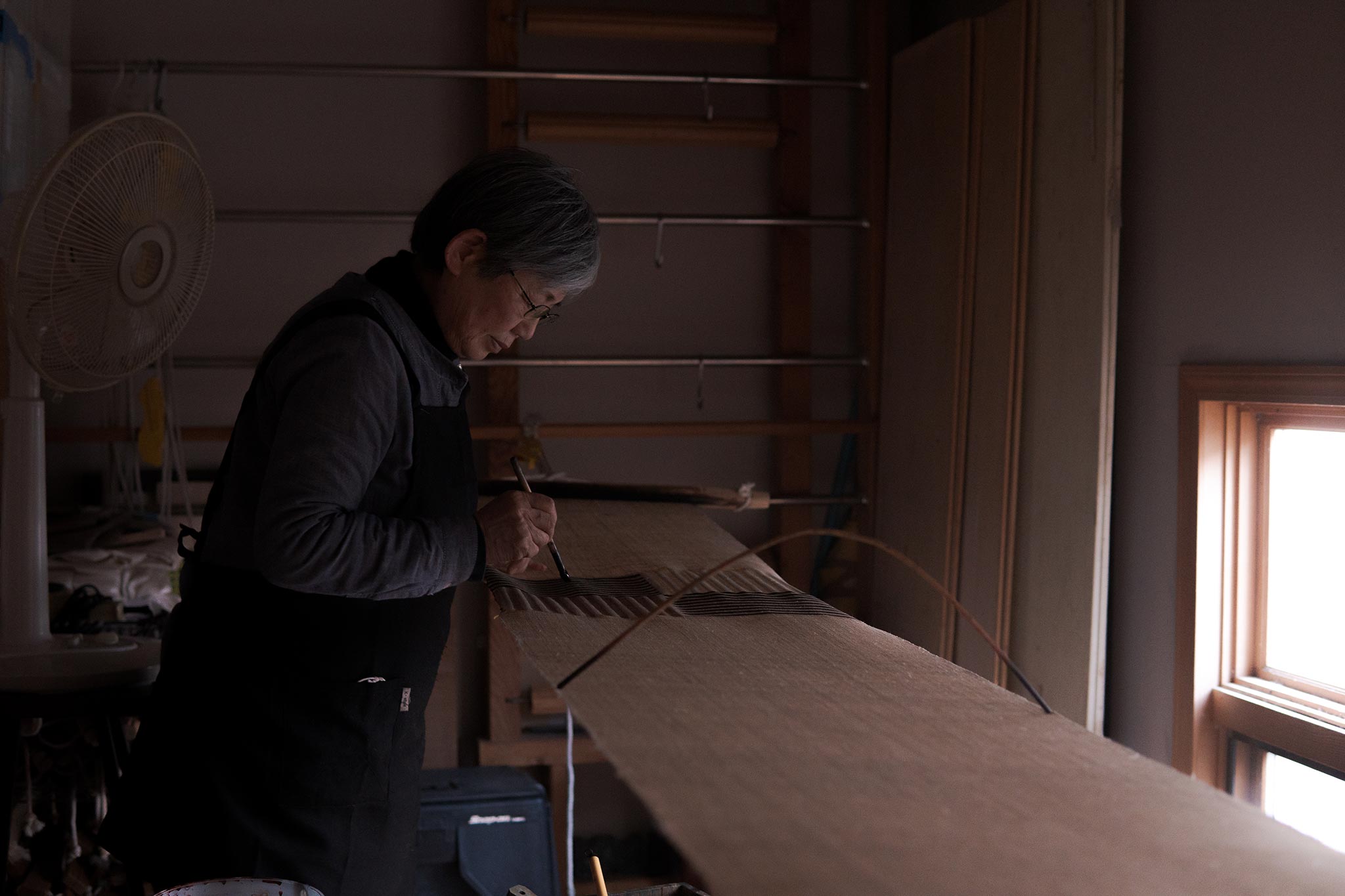
Watching her mother, Miwako, a dye-worker, work with such skill, it might seem that everyone in the family has been in the dyeing business for generations. But when talking to her, it is surprising that, as with her son, she came into the world with no experience at all.
She said,“I've been dyeing for 41-42 years now. I also made a curtain for the old shop of Asahiyaki. The first one was made in 2008. The previous generation of Asahiyaki was my junior in high school. My husband, who is one year younger than me, was in the mountaineering club in high school and your father was also in the club.”
“Originally I was a civil servant, which was completely unrelated. But I liked drawing pictures, textiles, was interested in many things. I thought about what I really wanted to do, and I finally found that I wanted to work with brushes and pencils. So I quit my job as a civil servant, and by chance I found a recruitment information in the newspaper for Yuzen craftsman. I applied it without thinking.
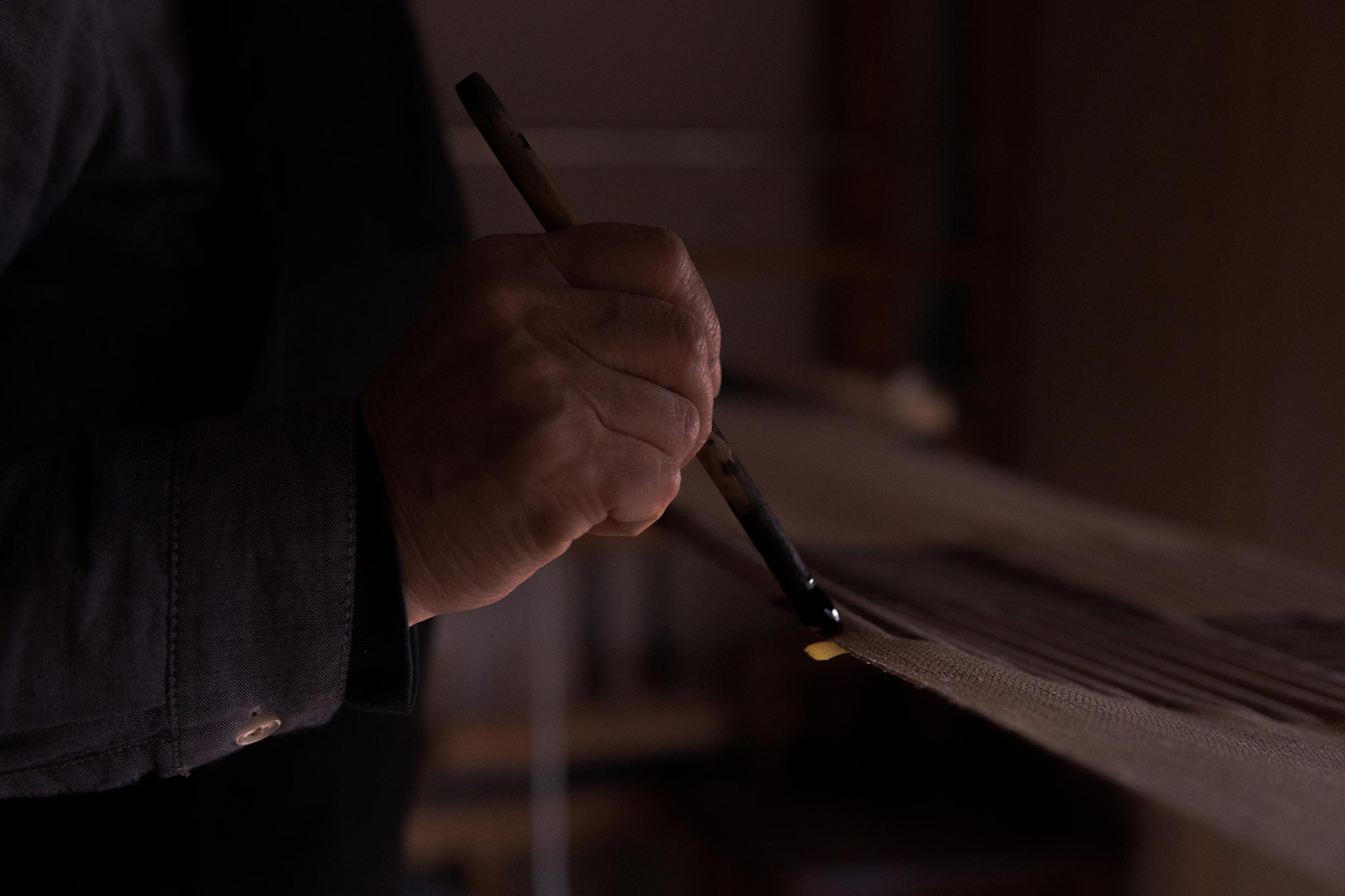

Miwako says that she “watched and learned” various techniques at two companies, Kaga Yuzen and Kyo Yuzen, but her natural curiosity turned into frustration day by day, and she gradually became bored with the repetitive, one-pattern work. She wanted to create her own colors and color the designs as she like. Then even if life got a little tough, she had to start a business on her own. In this way, the her sole company, Nagano Dyeing, was born.
“I tried many methods, and the one that suited me the most was not drawing itome* or wax painting, but just the traditional Japanese method of digging out a mold, placing glue on it, dyeing it, dyeing the back, steaming it, sewing it, and doing it all by myself.”
One day, Miwako decided to try dyeing hemp cloth. Silk is made of animal fiber, while hemp and cotton are plant fibers, so the dyes are completely different. At first, she did not even know the dyes used to dye hemp and cotton.
“There are a lot of books related to Yuzen. There are also many books on indigo dyeing and plant dyeing for cotton, but it was difficult to find the techniques for dyeing hemp with dyes with a brush. I thought, 'What should I do then?”
itome*: The white line on the outline of the pattern. Once the temporary picture wings with the rough sketches are untied, a thin layer of glue is placed along the rough sketches. This glue soaks into the fabric and acts as a bulwark, preventing the colors from blending together when the dye is inserted.
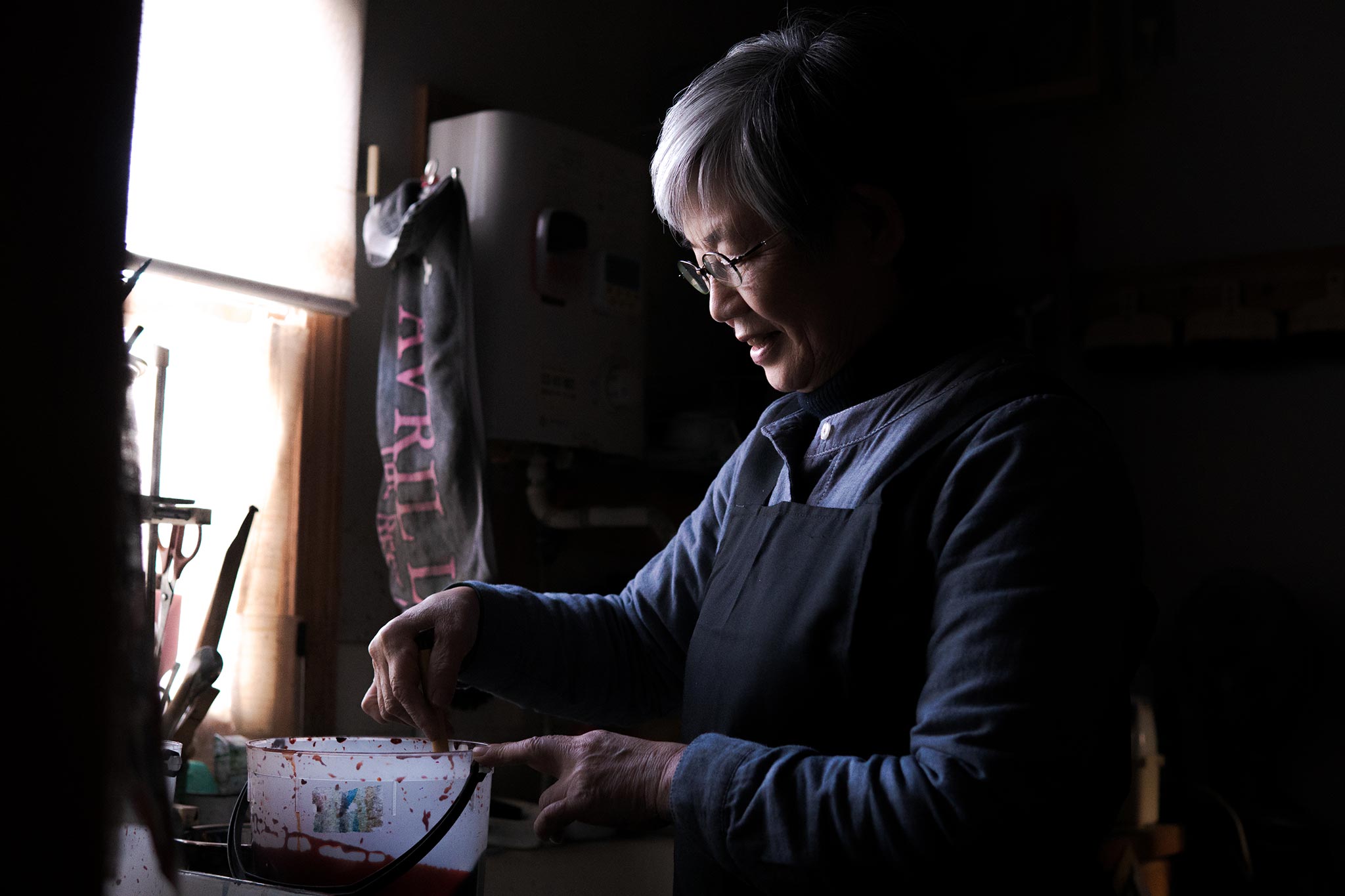

Since then, I have been self-taught, experimenting and failing every day. The best dyestuffs and their distribution for hemp, the best steaming time to fix the colours in the steaming process, and many other things were tested by myself, and step by step I accumulated the know-how of dyeing hemp.
I accumulated the know-how of dyeing hemp. “The principle of dyeing and fixing the colour through a chemical reaction is written in the books, however there's just a brief description of “steaming fixation”. I don't want to use too many chemicals and I want that steaming fixation, but the book doesn't mention the important things.”
She used to outsource her work to a steamer specialised in Yuzen, but this did not allow her to experiment. So Miwako decided to buy her own steamer. Since then she has been self-taught and experimenting with steaming fixation. She says that it took a lot of patience to find the right rules to reproduce the intended colours: if she wanted to create a calm colour and added a nigoshi colour, too much steaming would cause the colour to disappear, leaving only a light colour. If it happens to get a good colour by chance, she repeated the method of reproduction again and again.
This self-taught trial and error eventually led to the development of her own technique for dyeing linen. The dyeing of hemp, which is rare in Japan, is the result of a process of trial and error by small dyeing craftsmen in Uji, Kyoto.
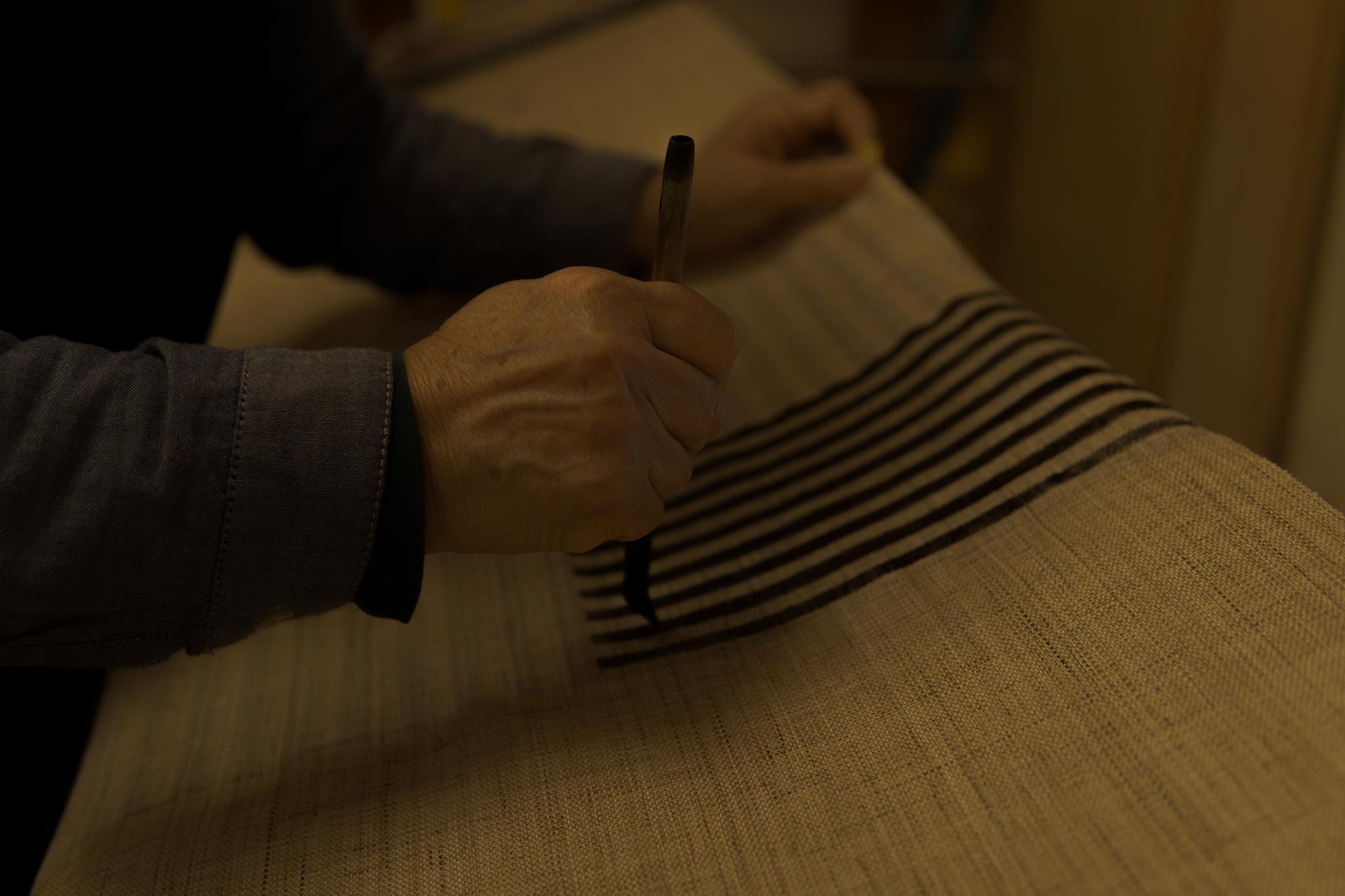
The charm of hemp dyeing lies in the colours it produces. If you dye the same colour on cotton and linen, you will obviously notice that the linen has a better colour. It is dyed with a dye so that it does not feel sticky, and all the two sides are dyed for a different depth.
“If you see hemp curtains elsewhere, they are often painted with pigments. But then you end up with just a colour on a plain fabric. No colour staining on the back. In my case, it's a dye, so the colour seeps into the backing. The hemp itself is dyed, so both sides are beautiful. It brings out the best of the hemp material itself.”
“The dyeing of hemp was started about 20 years ago by one of the staff who works in the studio and has helped me since the experimental stage. After that, I was able to produce a variety of colours, and the number of requests for shop front curtains increased significantly.”
The difficulty of making hemp noren was not only in the dyeing but also in the design. Miwako's designs are surprisingly simple, yet strangely pleasing and memorable. Like the furniture that Satoshi creates, the design comes in with everyday life naturally.
“I've been working in the kimono industry for a long time, so I had a lot of ideas for designs that I thought would be beautiful on noren. But in fact, if I bring the best part of the kimono design to the noren, it's not good at all. I realised that kimonos are only good for occasional wear, and that they are a distraction from the shop curtain you see every day.
So I started to eliminate more and more useless designs. We had to get down to the point where we couldn't cut any more. The lines became simpler and simpler. At first glance it looks as if anyone could draw it, but this is fine. It's a matter of trial and error to arrive at that simplicity. It's a method I've weeded out in my own way.”

“We have four people working here now, but none of us learnt the skills at school. I, as well as the three craftsmen who assist me, learned everything from scratch here, and together we learned by trial and error. And so is my son. I was never formally taught at school or at the workplace, so I had to learn by example and by stealing. I had to learn from my mistakes, didn't I?”
“Perhaps I don't actually understand the basics. I used to feel some complex about it. But now I'm proud of my self-taught path. I think it's because I'm self-taught that I can use the experience and make it my own. Isn't that the real profession of a craftsman?”
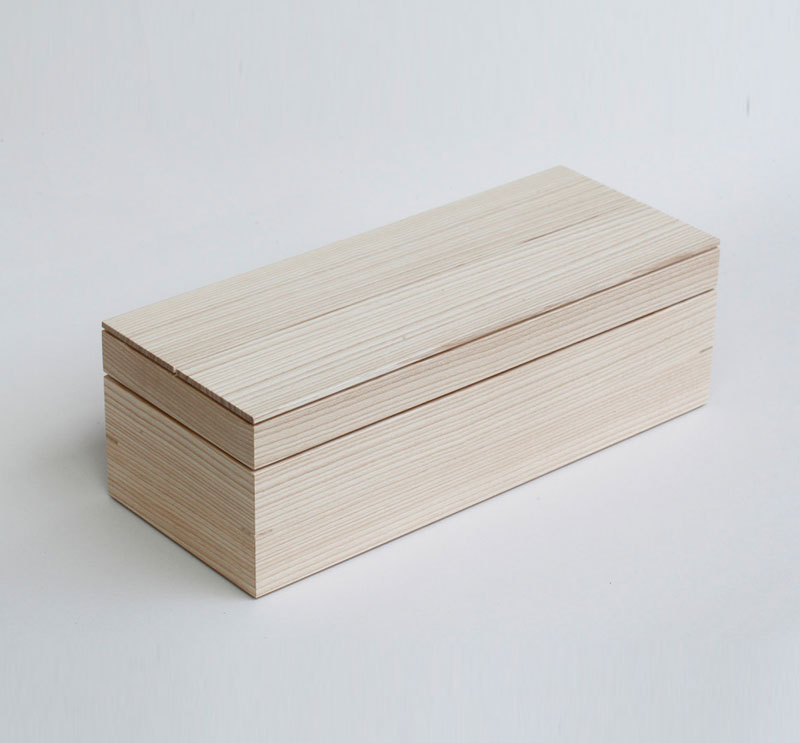
Price 24,200yen (tax included)
This tea box was commissioned by Mr. Satoshi Nagano, who studied woodworking in Finland. This tea box holds sencha tea utensils. The lid becomes a tray. The box is made from the Sen tree, which is found only in Japan.
Maker: Nagano Seisakusho
Size w340 x d135 x h110 mm
Material: Bottle wood
Coating: Osmocolor
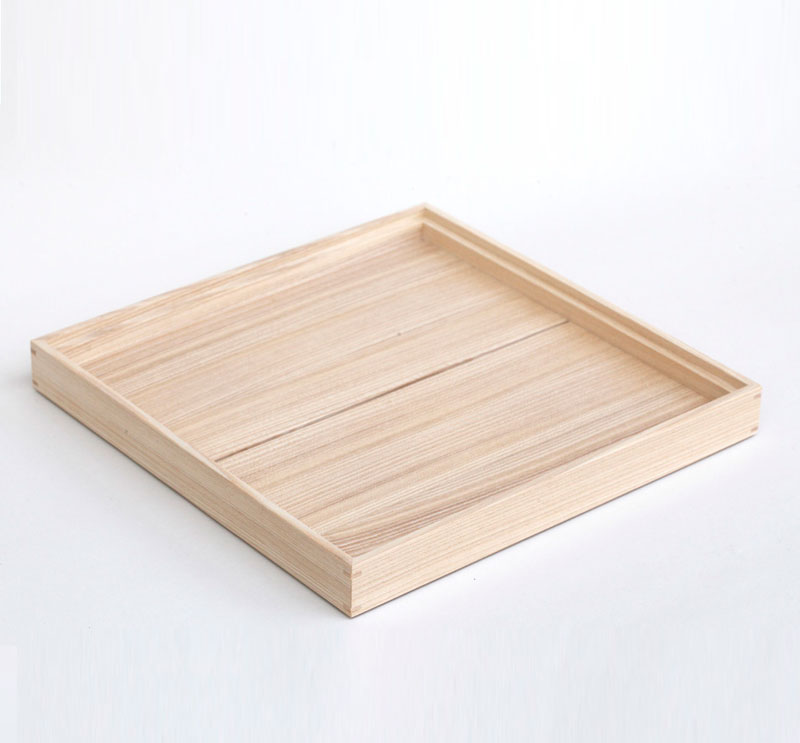
Price 11,000yen (tax included)
This tea tray was commissioned by Mr. Satoshi Nagano, who studied woodworking in Finland. It is a four-sided tray with an inner dimension of 8 cm (24 cm), which is easy to use when carrying tea utensils or brewing tea. This tray is made from the Sen tree, which is found only in Japan, and the more you use it, the more the wood's flavor grows.
Maker: Nagano Seisakusho
Size w240 x d240 x h28 mm
Material: Bottle wood
Coating: Osmocolor
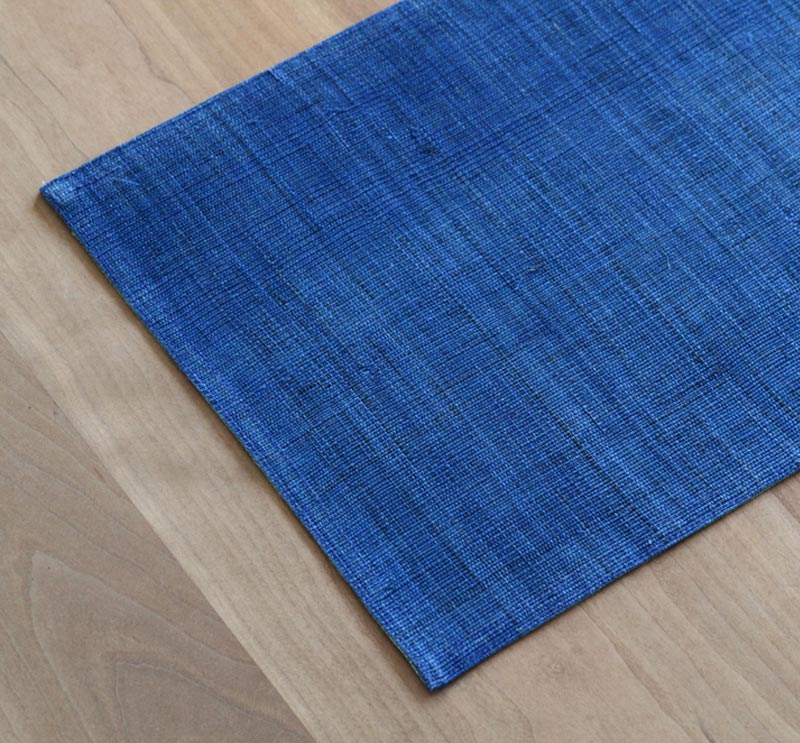
Price 3,960yen (tax included)
A tea mat made by NAGANO Dyeing to match ASAHIYAKI's tea pot set.The material of this tea mat is linen.
Maker: NAGANO Dyeing
Size 430×280×h1.5 mm